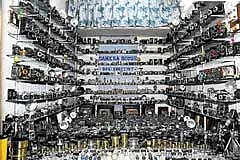

But tucked away in this busy street devoted to the gross world of foam and rubber is an ancient, unassuming, and weather-beaten two-story structure that unselfconsciously displays its peeling plaster and archaic design. Troop up the narrow steps to the second floor and you walk into Camera House, where some 4500 odd cameras have made home, and many others get restored.
Well, Camera House makes for an appropriate name, considering that the house devotes most of its space for C Sekar’s incredible collection of cameras. From midget cameras to mammoth ones, a crowd of rare cameras jostle for space from both shelves constructed specially for them, and also from boxes under the seats, boxes stacked against the walls and eating up most of the room space. Cameras have literally cornered this man’s life.
There is the first British-made ‘Ensign’ wooden piece camera, the 150-year-old ‘Glass Negative’ camera that uses glass for negatives, a 75-year-old tiny British Coronet Midget that is less than palm sized, and a small Minox lighter-cum-camera which can click a picture even as you light up a cigarette. “It was called a match box camera,” Sekar informs. This camera works only with an eight mm film, so Sekar cuts the 16 mm in the market to shoot pictures with it. There is also a 160-year-old camera, many suit-case sized wooden cameras, a German camera with 100 feet of film that had been used to photograph Mahatma Gandhi during the freedom struggle, a 16-mm movie camera (in which films are rolled by winding a key) used by Doordarshan to take footage of the 1962 Indo-Chinese war, a 90-year-old hand-held movie camera, a Paillard Bolex with three different lenses for close, mid and long ranges, an under water camera, tiny spy cameras…
Then, there are electronic memorabilia like writer and naturalist Harry Miller’s camera, LV Prasad’s 16-mm movie camera, and late Tamil film legend and Tamil Nadu’s Ex CM MGR’s Hasselblade and Gruernica, for which Sekar had shelled out Rs 80,000 to buy them from the family of MGR’s personal photographer Nagaraja Rao! Sekar has also been collecting camera accessories like films, lenses and flashes and says with a touch of confidence, “Even if you bring a 90-year-old camera to me, I’d probably be able to give you spare parts for the faulty parts.”
Down the years, Sekar has sacrificed many a luxury of life in his quest for collecting cameras. He has been dipping into his modest finances (from being a camera repair technician) for staging exhibitions of his collection. Year 2001 was first time he had his exhibition. “I had to save up from months to finance this,” he says. This is beside the fact that he has spent a good part of his salary in acquiring these rare cameras, often travelling across the country for these elusive but intriguing cameras. Maintenance is another big challenge; imagine caring for so many cameras! And keeping an inventory of so many cameras must be a challenging task in itself.
Looking around at the modest and cramped house, you pause to wonder, has it all been really worth it? “Yes, I have had to sacrifice both in terms of time and money; I can’t afford luxuries; I live in a rented house, while people with less talent than me have moved up in life. But, I find satisfaction in holding a rare, unique, and stupendous collection of electronic history — most of the kinds of cameras that were used in the last 160 years.”
Well, rare it is, and educational too. Camera house gets curious visitors through the month from around the world for some help regarding camera technicalities or just to have a look — aspiring students, technicians, curious onlookers and sometimes even company authorised camera technicians who seek Sekar’s expertise in sorting out a stubborn and faulty camera! He is happy to display his cameras to them, with technical explanations, all free of cost.
Thirty years back, as a lad, Sekar had moved to Chennai city from his native village over differences with his family (Sekar had insisted upon marrying out of caste). Thanks to his tinkering experience with gadgets, he took to electronics repair, which even helped fund his diploma in electronics. Electronic cameras had just then hit the market and observing a paucity of electronic camera repairers, an enterprising Sekar took to camera repair.
Handling cameras and getting absorbed in its intricacies, slowly, it struck Sekar that while there were people collecting and displaying anything and everything from stamps and coins to cars, nobody seemed to have gone in for a camera collection. “I could understand the hitch; cameras come costly,” he admits. “I said to myself, ‘Let me at least collect 10 cameras’.”
But passion makes for a demanding mistress, and the lure of cameras was such that Sekar’s camera collection now stands at an enviable 4500 odd cameras with 3000 of them in perfect working condition, and the remaining needing to be restored to working condition. “Repairing an antique camera requires roughly Rs 2000; for which I don’t have money. Some funding would be nice,” he says.
Aperture is the first camera he bought (from a photographer in Kolkata) for Rs 6,000. Now Aperture in an auction could fetch one lakh rupees. In fact, Sekar could easily sell off his cameras for a luxurious life, but he does not want to part with any of them. He yearns to display his camera collection in other cities, and even set up a permanent museum for them, but is held back by lack of funds. “I wish somebody would come forward to help. I don’t want to make a profit out of these cameras. I just want to preserve them all in a museum for posterity.”
